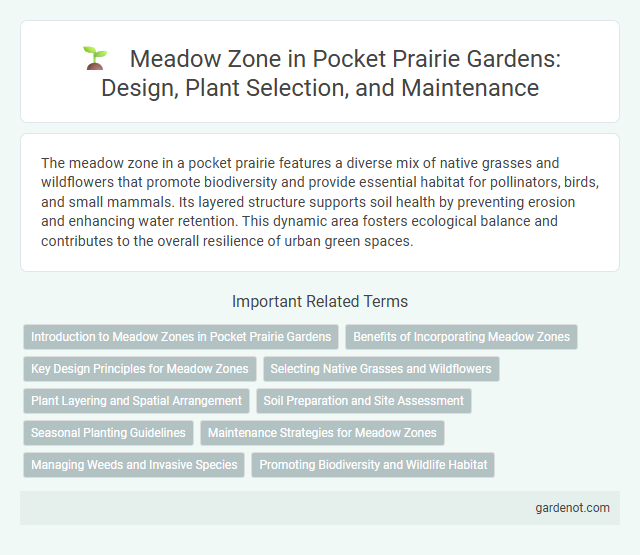The meadow zone in a pocket prairie features a diverse mix of native grasses and wildflowers that promote biodiversity and provide essential habitat for pollinators, birds, and small mammals. Its layered structure supports soil health by preventing erosion and enhancing water retention. This dynamic area fosters ecological balance and contributes to the overall resilience of urban green spaces.
Introduction to Meadow Zones in Pocket Prairie Gardens
Meadow zones in Pocket Prairie Gardens feature diverse native grasses and wildflowers that support local pollinators and enhance biodiversity. These zones require minimal maintenance, promoting natural growth cycles while improving soil health and water retention. Integrating meadow zones creates vibrant habitats that sustain wildlife and foster ecological balance within urban landscapes.
Benefits of Incorporating Meadow Zones
Meadow zones in pocket prairies enhance biodiversity by providing habitat for pollinators such as bees and butterflies, which support local ecosystems and improve plant pollination rates. These zones contribute to soil health through deep root systems that prevent erosion and increase nutrient cycling. Incorporating meadow zones also aids in stormwater management by improving water infiltration and reducing runoff, thus mitigating urban flooding risks.
Key Design Principles for Meadow Zones
Meadow zones in pocket prairies prioritize native plant diversity, soil health, and layered vegetation structure to support pollinators and wildlife habitat. Key design principles include selecting regionally appropriate species with staggered bloom periods, minimizing turf grass to reduce maintenance, and incorporating pathways for accessibility and visitor experience. Proper soil preparation and adaptive management enhance ecosystem resilience and promote long-term sustainability.
Selecting Native Grasses and Wildflowers
Selecting native grasses and wildflowers for a pocket prairie's meadow zone enhances biodiversity by providing habitat and food sources for pollinators and wildlife. Employing species such as Little Bluestem, Purple Coneflower, and Black-eyed Susan ensures ecological adaptability and resilience to local soil and climate conditions. Native plants promote soil health, reduce maintenance needs, and support ecosystem stability in urban and suburban environments.
Plant Layering and Spatial Arrangement
In the Meadow zone of a pocket prairie, plant layering enhances biodiversity by incorporating a vertical structure of grasses, wildflowers, and groundcovers that support various pollinators and wildlife. Spatial arrangement optimizes sunlight capture and nutrient uptake through strategic grouping of deep-rooted perennials and shallow-rooted species, promoting ecosystem resilience. This multilayered approach fosters efficient resource utilization and creates microhabitats crucial for sustaining native pollinator populations.
Soil Preparation and Site Assessment
For optimal soil preparation in the meadow zone of a pocket prairie, conduct thorough site assessments focusing on soil texture, pH levels, and organic matter content to support native grasses and wildflowers. Remove existing turf and weeds through solarization or manual tilling, ensuring the soil is loose yet firm to enhance root establishment. Incorporate compost or aged manure to enrich nutrient levels and improve soil structure, promoting long-term prairie health.
Seasonal Planting Guidelines
Meadow zones in pocket prairies thrive with seasonal planting strategies that emphasize native wildflowers and grasses to support biodiversity. Early spring planting of cool-season natives such as lupines and coneflowers promotes strong root development, while warm-season species like switchgrass and black-eyed Susan should be introduced during late spring to midsummer for optimal growth. Maintaining a staggered seeding schedule ensures continuous bloom cycles, enhancing pollinator habitats and soil health throughout the growing season.
Maintenance Strategies for Meadow Zones
Effective maintenance strategies for pocket prairie meadow zones include periodic mowing, typically once or twice annually, to prevent woody plant encroachment and promote native wildflower diversity. Selective invasive species removal and monitoring soil health ensure long-term ecosystem resilience and enhance pollinator habitat quality. Implementing adaptive management practices based on seasonal growth patterns maximizes plant community stability and biodiversity.
Managing Weeds and Invasive Species
Effective weed and invasive species management in the Meadow zone involves regular monitoring and targeted removal to preserve native plant diversity. Utilizing techniques such as hand-pulling, selective herbicide application, and mulching can prevent invasive species like Canada thistle and leafy spurge from dominating the area. Maintaining healthy native vegetation through proper mowing regimes and soil management promotes resilience against invasive encroachment in pocket prairie meadows.
Promoting Biodiversity and Wildlife Habitat
The Meadow zone in a pocket prairie fosters biodiversity by providing a diverse array of native grasses and wildflowers that support pollinators like bees and butterflies. This habitat offers shelter and food sources for birds, small mammals, and beneficial insects, enhancing the local ecosystem's resilience. By mimicking natural prairie ecosystems, the Meadow zone promotes ecological balance and strengthens wildlife corridors in urban environments.
Meadow zone Infographic

 gardenot.com
gardenot.com